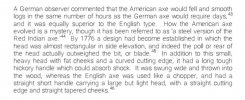-
The BladeForums.com 2024 Traditional Knife is ready to order! See this thread for details: https://www.bladeforums.com/threads/bladeforums-2024-traditional-knife.2003187/
Price is$300$250 ea (shipped within CONUS). If you live outside the US, I will contact you after your order for extra shipping charges.
Order here: https://www.bladeforums.com/help/2024-traditional/ - Order as many as you like, we have plenty.
You are using an out of date browser. It may not display this or other websites correctly.
You should upgrade or use an alternative browser.
You should upgrade or use an alternative browser.
Interesting info
- Thread starter Woodcraft
- Start date
- Joined
- Nov 7, 2016
- Messages
- 796
I feel this source as well as several others highlights the evolution and issue with some axes. This writing is from the Australian perspective but comes to the same conclusion reached by Cornwallis in America. So many points to be made with the Cornwallis letter.......Interesting! The sheer volume of trees and brush that needed to be cut and cleared by homesteaders would have guided axe evolution for sure.
Not only were the American axes Superior but one comes to the conclusion the Massachusetts men themselves that he hired were Superior workers as well. Perhaps it was tool and technique, perhaps it was more.
In this writing it becomes clear it was a multitude of issues. Axes were sourced from multiple places, England, Germany and they were inferior. Not only in one manner or another but in ALL aspects. The geometry was all wrong for the Felling job. The handles were horrible. We have documentation of the axes twisting in the work. And of course inferior manufacturing and specifically poor heat treat that caused headaches on harder timber.
The handle is no small matter but it clearly can be felt in this writing that it was FAR Superior and a huge advantage.
The quite simple and to the point description of both types of axes and how they are used also highlights the superiority of the American Felling ax. More important it does so in a way that non ax users should be able to understand. It pulls back the sheet so to speak for the non experienced ax user. The American ax is "thrown" in an arc utilizing the heft of the head and releases easy due to cheek shape. The other has to be used in a "chopping manner". As expected. It lacks the weight to do the work. It lacks the geometry for release so over Penetration is a real issue. That is kind of a kick in the butt for those arguing for them as a bucking Felling alternative, light weight, Penetration and removability of the handle are the modern selling points of these axes. Yet they are also the exact things that make them a poor choice for Felling and bucking. It really is not opinion, it is fact.
Another interesting point is on the dimensions reached by competitors and manufacturers on dimensions. As one views the overall shape and perhaps more of the "general ideas/dimensions" of the agreed ax it seems to me that a couple of patterns come very close to the spirit of the description. Just interesting.
I think it can be shown quite conclusively that when it comes to Felling and bucking the American Felling ax is far superior to all others. I will extend the nod to the Australian/New Zealand ers as they have a sibling ax that is obviously a child of the American Felling ax and experience on local woods.
Last edited:
- Joined
- Jan 15, 2001
- Messages
- 3,884
Could a factor be that in America a lot of the trees being cut would be considered "Old Growth" trees, significant larger than those found in Europe? John
- Joined
- Nov 7, 2016
- Messages
- 796
Yes. As well as volume. And differing hardness of timber. Those are the factors that forced the change. Both here and then Australia. That is what is so interesting with this article to me. Those factors forced the change to a more efficient, effective better built longer lasting tool. The American felling ax.Could a factor be that in America a lot of the trees being cut would be considered "Old Growth" trees, significant larger than those found in Europe? John
Hours vs same no of days? Well...mr. Observer, give me a break and lay down the Schapps  .
.
I'm visiting Hallstatt, and I understand why they treasure so much their 3000 year-old pine and fir stair - in case another one breaks, they'll use it as a spare, instead of making a new one. It would take forever.
I'm visiting Hallstatt, and I understand why they treasure so much their 3000 year-old pine and fir stair - in case another one breaks, they'll use it as a spare, instead of making a new one. It would take forever.
Last edited:
- Joined
- Nov 7, 2016
- Messages
- 796
I'll take a stab at it. Maine pine is a joke. I can not speak to Felling volumes with a hand saw first hand. But I can post a video of the old timers going through one like butter at ground,(snow level) with smiles seemingly effortless. And I have plenty of experience throwing an ax and chainsaw into the stuff. As far as bucking, there is a reason I call out mainers who use it as an example to showcase the "ability" of the flavor of the week ax.Where do Maine wedge patterns* fit in the scheme of things?
*I've only seen pictures of them - those aren't something we find around here (at least I don't anyway)
Green pine crumbles like cheese. It is soft and needs a big push, but you can blow HUGE chips.
At first Maine was known for hardwoods and shipbuilding material. But let's be honest, Maine ax users turned into pulp harvesters and firewood splitters.
I would venture a guess that the Maine wedge is the end result of an ax used on pine and for splitting.
I would not choose a Maine wedge if I was bucking some old maple
- Joined
- Mar 31, 2016
- Messages
- 1,927
i was thinking that maine axes looked a little small for the work they had to do, and they didnt fit ideology of "get a bigger axe for bigger work" of the time and now i know why. i dont have any experience with pine, all my axes are tested on dry red oak. i'd love to have a maine but i probly wouldnt use it because id be too scared of messing it up. as far as an axe like a maine axe, i have that role filled. truck-sized fire axes are wonderful things
- Joined
- Nov 7, 2016
- Messages
- 796
In Maine we were circling back pretty quickly to re cut land. If you will. So the trees were not all that big. Especially considering the whole wood cutting blitz started on the east coast.i was thinking that maine axes looked a little small for the work they had to do, and they didnt fit ideology of "get a bigger axe for bigger work" of the time and now i know why. i dont have any experience with pine, all my axes are tested on dry red oak. i'd love to have a maine but i probly wouldnt use it because id be too scared of messing it up. as far as an axe like a maine axe, i have that role filled. truck-sized fire axes are wonderful things




